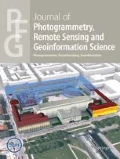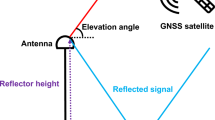Abstract
In space-borne remote sensing, one of the most significant tasks is the three-dimensional (3D) surface modelling performance of optical and synthetic aperture radar (SAR) satellite missions. In this study, the quality of Sentinel-1A (S-1A) and Advanced Land Observing Satellite (ALOS) World 3D 30 m (AW3D30) Digital Surface Models (DSMs) was comprehensively analysed. In addition, 1 arcsec Shuttle Radar Topography Mission (SRTM) C-band DSM was validated for better interpretation of the results. A project area including various land cover classes was selected in Istanbul, where a reference airborne laser scanning DSM is available. Optimal S-1A interferometric wide (IW) swath SAR pairs were determined and a 15 m gridded DSM was generated by interferometric processing. AW3D30 and SRTM DSMs were obtained from JAXA and NASA. In the analysis, the absolute and relative vertical accuracies of the DSMs were validated for all land cover classes with a model-to-model comparison to the reference. In addition, the influence of terrain tilt was investigated using a threshold terrain inclination of tan−1 0.1 (5.7°). Height differences from the reference were visualized by colour-coded height error maps. Vertical profiles and contour lines showed the morphologic character of the DSMs. The results demonstrated that the absolute vertical accuracies and morphologic details of AW3D30 are superior to those of S-1A and SRTM.
Zusammenfassung
Validierung eines Digitalen Oberflächenmodells von Sentinel-1A und AW3D30 für die Metropolregion Istanbul, Türkei Bei der weltraumgestützten Fernerkundung ist die dreidimensionale (3D) Oberflächenmodellierung aus Daten von Satellitenmissionen mit optischem Aufnahmesystem oder synthetischer Apertur (SAR) eine wichtige Aufgabe. In dieser Studie wurde die Qualität eines digitalen 3D-Oberflächenmodells (DOM) aus Daten des Sentinel-1A (S-1A) und das Advanced Land Observing Satellite (ALOS) World 3D 30 m (AW3D30) umfassend analysiert. Darüber hinaus wurde ein 1-Bogensekunden-Shuttle-Radar-Topography-Mission (SRTM) C-Band DSM zur besseren Interpretation der Ergebnisse herangezogen. Als Projektgebiet diente ein Ausschnitt Istanbuls mit verschiedenen Landbedeckungsklassen, in dem ein DOM aus Laserscannerdaten verfügbar war. Optimale S-1A Interferometric Wide (IW) Streifen-SAR-Paare wurden bestimmt, und ein 15 m Raster-DOM durch interferometrische Verarbeitung erzeugt. AW3D30- und SRTM-DOM wurden von der JAXA und der NASA bezogen. Die Analyse enthält eine Validierung der absoluten und relativen vertikalen Genauigkeiten der DOM für alle Landbedeckungsklassen, erstellt mit einem Modell-zu-Modell-Vergleich mit der Referenz. Zusätzlich wurde der Einfluss der Geländeneigung mit einem Schwellenwert von tan−1 0.1 (5.7°) untersucht. Höhenunterschiede zur Referenz wurden durch farbcodierte Höhenfehlerkarten visualisiert. Vertikale Profile und Konturlinien zeigten den morphologischen Charakter der DOM. Die Ergebnisse zeigen, dass die absoluten vertikalen Genauigkeiten und morphologischen Details von AW3D30 denjenigen von S-1A und SRTM überlegen sind.











Similar content being viewed by others
References
Bamler R (2006) Radar interferometry for surface deformation assessment. Summer School Alpbach 2006: monitoring of natural hazards from space. https://www.ffg.at/getdownload.php?id=234
Chen CW, Zebker HA (2000) Network approaches to two-dimensional phase unwrapping: intractability and two new algorithms. J Opt Soc Am 17:401–414
Chen F, Lin H, Yeung K, Cheng S (2010) Detection of slope instability in Hong Kong based on multi-baseline differential SAR interferometry using ALOS PALSAR data. GISci Remote Sens 47(2):208–220
Christie M, Tsoflias GP, Stockli DF, Black R (2009) Assessing fault displacement and off-fault deformation in an extensional tectonic setting using 3-D ground-penetrating radar imaging. J Appl Geophys 68(1):9–16
De Zan F, Monti Guarnieri AM (2006) TOPSAR: terrain observation by progressive scans. IEEE Trans Geosci Remote Sens 44(9):2352–2360
Dell’Acqua F, Gamba P (2010) Rapid mapping using airborne and satellite SAR images, radar remote sensing of urban areas. In: Soergel U (ed) Remote sensing and digital image processing. Springer, Netherlands, pp 49–68
Ferretti A, Monti Guarnieri A, Prati C, Rocca F, Massonnet D (2007) InSAR principles: guidelines for SAR interferometry processing and interpretation. ESA Publications, Noordwijk (ISSN 1013-7076). ISBN 92-9092-233-8
Font M, Amorese D, Lagarde JL (2010) DEM and GIS analysis of the stream gradient index to evaluate effects of tectonics: the Normandy intraplate area (NW France). Geomorphology 119(3–4):172–180
Fraser CS (2003) Prospects for mapping from high-resolution satellite imagery. Asian J Geoinf 4(1):3–10
Gan TY, Zunic F, Kuo CC, Strobl T (2012) Flood mapping of Danube River at Romania using single and multi-date ERS2-SAR images. Int J Appl Earth Obs Geoinf 18:69–81
Gatelli D, Kucherenko S, Ratto M, Tarantola S (2009) Calculating first-order sensitivity measures: a benchmark of some recent methodologies. Reliab Eng Syst Saf 94(4):1212–1219
Goldstein RM, Werner CL (1998) Radar interferogram filtering for geophysical applications. Geophys Res Lett 25(21):4035–4038
Hu Z, Peng J, Hou Y, Shan J (2017) Evaluation of recently released open global digital elevation models of Hubei, China. Remote Sens 9(262):1–16
Jacob A, Ban Y (2015) Sentinel-1A SAR data for global urban mapping: preliminary results. In: Proceedings of IGARSS, pp 1179–1182
Jacobsen K (2005) DEMs based on space images versus SRTM height models. In: ASPRS annual convention, Baltimore
Jacobsen K (2007) Digital height models by CARTOSAT-1. Int Arch Photogramm Remote Sens Spat Inf Sci 36(1/W51):6 (on CD-ROM)
Jacobsen K (2016a) Analysis and correction of systematic height model errors. ISPRS Arch XLI-B1:333–339
Jacobsen K (2016b) Ersatz des SRTM Oberflächenmodells durch AW3D30?. Drei-Länder-Tagung, Bern
Jain MK, Singh VP (2005) DEM-based modelling of surface runoff using diffusion wave equation. J Hydrol 302(1–4):107–126
López-Quiroz P, Doin M, Tupin F, Briole P, Nicolas J (2009) Time series analysis of Mexico City subsidence constrained by radar interferometry. J Appl Geophys 69(1):1–15
Nikolakopoulos K, Kyriou A (2015) Preliminary results of using Sentinel-1 SAR data for DSM generation. Eur J Geogr 6(3):52–68
Ranganath RN, Jayaraman V, Roy PS (2007) Remote sensing applications: an overview. Curr Sci 93(12):1747–1766
Rucci A, Ferretti A, Monti Guarnieri A, Rocca F (2012) Sentinel-1 SAR interferometry applications: the outlook for sub millimeter measurements. Remote Sens Environ 120(2012):156–163
Santillan J, Makinano-Santillan M (2016) Vertical accuracy assessment of 30 m resolution ALOS, ASTER, and SRTM global DEMs over Northeastern Mindanao, Philippines. ISPRS Int Arch Photogramm Remote Sens XLI-B4:149–156
Schmidt F, Persson A (2003) Comparison of DEM data capture and topographic wetness indices. Precis Agric 4(2):179–192
Sefercik UG (2012) Performance estimation of ASTER global dem depending upon the terrain inclination. J Indian Soc Remote Sens 40(4):565–576
Sefercik UG, Soergel U (2010) Comparison of high resolution InSAR and optical DEMs. In: EARSeL workshop, 22–24 September, Gent, Belgium (on CD)
Sefercik UG, Yastikli N (2016) ALS model-based comparison of Cosmo-SkyMed and TerraSAR-X HS DSMs on varied land forms. J Spat Sci 61(1):119–131
Sefercik UG, Alkan M, Buyuksalih G, Jacobsen K (2013) “Generation and validation of high-resolution DEMs from worldview-2 stereo data. Photogramm Rec 28(144):362–374 (Wiley Blackwell (ISI))
Sefercik UG, Glennie C, Singhania A, Hauser D (2015) Area-based quality control of airborne laser scanning 3D models for different land classes using terrestrial laser scanning: sample survey in Houston, USA. Int J Remote Sens 36(23):5916–5934
Sefercik UG, Buyuksalih G, Jacobsen K, Alkan M (2017) Point-based and model-based geolocation analysis of airborne laser scanning data. Opt Eng 56(1):013101
Seymour MS, Cumming IG (1997) InSAR terrain height estimation using low-quality sparse DEMs. In: Proceedings of 3rd ERS symposium, Florence, Italy, 18–21 March 1997
Stereńczak K, Kozak J (2011) Evaluation of digital terrain models generated in forest conditions from airborne laser scanning data acquired in two seasons. Scand J For Res 26(4):374–384
Tadono T, Nagai H, Ishida H, Oda F, Naito S, Minakawa K, Iwamoto H (2016) Generation of the 30 M-mesh global digital surface model by ALOS PRISM. ISPRS Ann Photogramm Remote Sens 41:157–162
Takaku J, Tadono T, Tsutsui K (2014) Generation of high resolution global DSM from ALOS PRISM. Int Arch Photogramm Remote Sens Spat Inf Sci XL-4:243–248
Veci L (2016) Sentinel-1 toolbox, TOPS interferometry tutorial. Array Systems Computing Inc., Toronto
Yague-Martinez N, Prats-Iraola P, Rodriguez Gonzalez F, Brcic R, Shau R, Geudtner D, Eineder M, Bamler R (2016) Interferometric processing of Sentinel-1 TOPS data. IEEE Trans Geosci Remote Sens 54(4):2220–2234
Yastikli N, Sefercik UG, Esirtgen F (2014) Quantitative assessment of remotely sensed global surface models using various land classes produced from landsat data in Istanbul. Chin Geogr Sci 24(3):307–316
Zhang F, Xu M, Xie C, Xia Z, Li K, Wang X (2012) Forest and deforestation identification based on multitemporal polarimetric RADARSAT-2 images in Southwestern China. J Appl Remote Sens 6(1):063527
Acknowledgements
Thanks are going to ESA, JAXA, and NASA for providing Sentinel-1, ALOS, and SRTM data for analysis.
Author information
Authors and Affiliations
Corresponding author
Rights and permissions
About this article
Cite this article
Sefercik, U.G., Buyuksalih, G., Atalay, C. et al. Validation of Sentinel-1A and AW3D30 DSMs for the Metropolitan Area of Istanbul, Turkey. PFG 86, 141–155 (2018). https://doi.org/10.1007/s41064-018-0054-3
Received:
Accepted:
Published:
Issue Date:
DOI: https://doi.org/10.1007/s41064-018-0054-3




